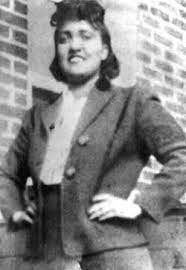7 Henrietta Lacks
Henrietta Lacks
|
 |
Time period: 1920 – 1951Subject: Cell Biology – Medicine |
|
Biography:Henrietta Lacks was born in 1920 in Virginia, USA. She wasn’t a “scientist”… But this Black American woman deserves a page in our diverse scientist book for her indirect contributions to the field of biology, biotechnology, and medicine. The story of Henrietta Lacks illustrates the racial inequities that are embedded in the US research and health-care systems. Henrietta was the mother of five children and loved to cook and dance with her children in the arms. One day, she visited one of the only hospitals that was taking care of black people, the Johns Hopkins Hospital, for vaginal bleeding. Upon examination, the renowned gynecologist Dr. Howard Jones discovered a large, malignant tumor on her cervix. Mrs. Lacks began undergoing radium treatments for her cervical cancer. Her doctor also collected, without her knowledge and consent, a sample of her cancer cells during a biopsy and sent it to a laboratory in the hospital. The focus of that lab was to look for cells that would live in a petri dish under artificial conditions. They had been trying many different samples from women with cervix cancer, but no cells had ever survived. Until Henrietta’s cells. Her cells would not only survive, but double in 24 h when cultivated in the right medium: they were immortal! The main researcher shared those cells with other scientists, and they became a phenomenal tool for biological research and modern medicine. |
|
Summary of her contributions:Henrietta Lacks’ cells (HeLa cells) have been involved in major discoveries in many different fields including cancer, immunology, cell biology and virology. One of their most recent applications has been in research for vaccines against COVID-19. None of the biotechnological companies that used Mrs. Lacks’ cells gave any money back to her family. Moreover, doctors and scientists never asked her family for consent while mentioning Mrs. Lacks’ name in public, giving her record to the public, or even publishing her cells’ genome online! Today, HeLa cells are EVERYWHERE. Only few cell biologists can say today that they never used HeLa cells for their research. They grow so fast that it is now believed that there are HeLa cells mixed in every other cell cultures in labs. It is important to remember that behind those four letters is a person, a woman, whose basic rights and those of her family were disrespected because of her color. It is also important to acknowledge her indirect contributions to science. Thank you, Mrs. Lacks! |
|
Integration with the BC Secondary Science Curriculum:Cancer, Cell biology, Cell cycle, DNA, Vaccine |
|
References:Johns Hopkins Medicine. https://www.hopkinsmedicine.org/henriettalacks/ Editorial, 2020. Henrietta Lacks: science must right a historical wrong. Nature 585, 7 (2020). https://doi.org/10.1038/d41586-020-02494-z |
|
